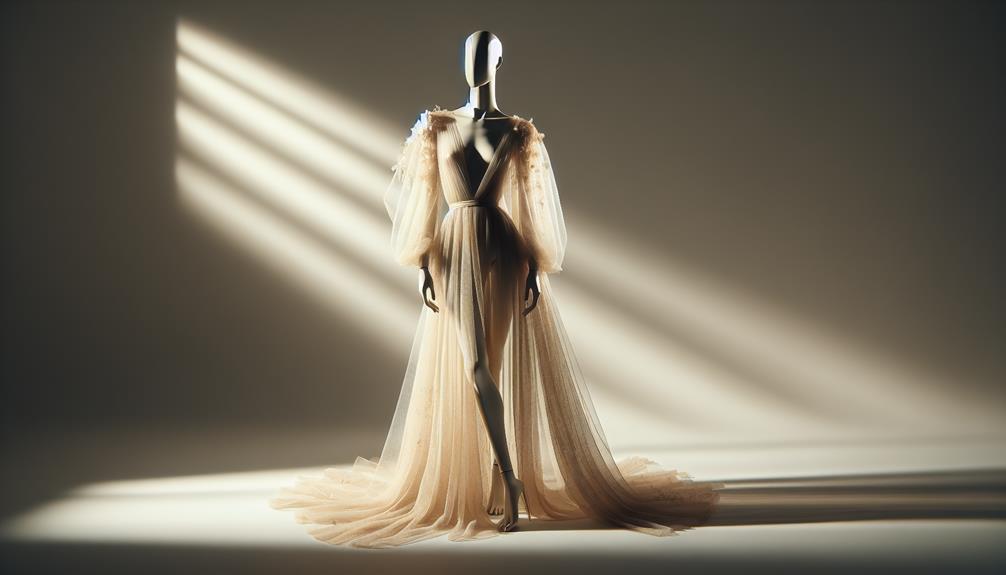Yes, organza does hold its shape pretty well, especially if it's made from silk. Silk organza is stiffer due to its natural protein structure, which lets it maintain a crisp texture. The synthetic versions, like those made from polyester or nylon, are also good at keeping their form, and they're a bit tougher and more durable. The tight weave of the fabric plays a big part in this, balancing delicate appearance with firmness. So whether it's for a dress that needs to pop or a fancy decoration, organza can be a great choice. There's even more about how it compares to other materials.
Table of Contents
Key Takeaways
- Organza is known for its stiffness and ability to maintain shape, especially in garments.
- Silk organza offers more rigidity due to its natural protein structure.
- Synthetic organzas like polyester are durable and spring back to shape easily.
- The tight plain weave of organza contributes to its firm yet delicate structure.
- Organza is ideal for designs requiring volume and defined contours, unlike softer fabrics like chiffon.
Understanding Organza Fabric
Organza is a lightweight, sheer fabric traditionally made from silk, although synthetic versions like polyester are also common. I've always found its delicate appearance quite deceptive because it's much tougher than it looks. This fabric isn't just about looks; it's got a lot of practical uses too, especially when I need something with a bit of stiffness yet graceful.
When I work with organza, I'm struck by its crisp texture. It's not like cotton or wool that feels cozy and warm. No, organza is crisp, almost like handling a thin layer of frost that won't melt away. This makes it excellent for creating those stunning, stand-out features in garments that you might see in high fashion or on stage costumes.
Handling organza can be tricky because of its delicate nature. I need to be careful not to pull too hard or get it caught on something sharp. It frays pretty easily, and any damage can be quite noticeable because of its transparency. But once I get the hang of it, it's rewarding to see how beautifully it layers and captures light, adding depth and dimension to my designs.
Organza's Material Composition
While we've explored how organza feels and handles, it's also important to look at what it's actually made of. Organza is traditionally crafted from silk, making it one of the more luxurious fabrics out there. However, modern versions are often made from synthetic fibers like polyester or nylon. These materials help make the fabric more accessible and affordable.
The choice of material affects not just the cost but also how organza behaves. Silk organza is quite different from its synthetic counterparts. It's lighter and has a subtle sheen that the synthetic versions usually can't match. On the other hand, polyester and nylon organzas are more durable and easier to care for. They resist wrinkles and can handle moisture better.
When you're picking organza for a project, it's crucial to consider these differences. Each type has its own benefits and drawbacks. Silk organza works beautifully for more delicate, high-end items. Meanwhile, polyester or nylon organza could be a better choice for everyday use or for items that need more durability.
Understanding these material basics will help you make informed decisions whether you're buying or working with organza. It's all about choosing the right type for your needs.
Stiffness and Durability Factors
Let's now focus on how stiff and durable organza can be, based on its material makeup. When we talk about stiffness in organza, it's all about the fibers used. Silk organza, for instance, is naturally stiffer than synthetic versions like polyester organza. This stiffness is crucial because it's what gives organza that crisp, structured look that works so well in fashion and décor.
Durability, on the other hand, is a bit more complicated. Silk organza is delicate. It can snag or fray if you're not careful. That's something to keep in mind if you're planning to use it in something like a daily-wear item or in an area with high traffic. Polyester organza is tougher. It can handle more wear and tear, making it a better option for heavy-duty use.
Impact of Weave on Shape
Moving on, the way organza is woven significantly affects its ability to maintain shape.
Let's dive into that. Organza is typically made using a plain weave. This is one of the simplest weaving techniques where the warp and weft threads cross over and under each other alternately. Sounds simple, right? But here's where it gets interesting.
The tightness of this weave creates a balance that's not just delicate but also surprisingly firm. Because of this, organza can hold shapes that other fabrics might not. Think about those crisp, stand-out details on dresses or curtains — that's organza doing its job.
Now, it's not just about the weaving technique but also about the material used. Organza is often made from silk, polyester, or nylon. Each of these materials responds differently under the same weave. Silk organza, for instance, is stiffer due to its natural protein structure. Polyester and nylon, being synthetic, offer a bit more resilience, which means they can spring back to shape more readily after being bent or twisted.
Comparing Organza With Other Fabrics
Now, let's compare organza to other fabrics like chiffon and cotton.
We'll look at how durable organza is compared to chiffon and how flexible it's next to cotton.
This will help us see if organza really holds up better or not.
Organza Vs. Chiffon Durability
When comparing the durability of organza and chiffon, organza generally offers more resilience. Organza's tightly twisted fibers make it tougher and more structured. It stands up better to wear and tear.
Chiffon, on the other hand, is lighter and more delicate. It's made from silk or synthetic fibers like polyester, which aren't as strong. This makes chiffon prone to snags and tears, especially if you're not careful.
I've noticed that organza maintains its shape and texture even after multiple uses. It's ideal for garments that need to hold their form.
Chiffon is great for flowy, ethereal looks, but it doesn't last as long. For projects needing durability, I always lean towards organza. It's a reliable choice.
Flexibility: Organza Vs. Cotton
In comparing the flexibility of organza with cotton, it's clear that cotton offers more give and adaptability. Cotton is soft, cozy, and it stretches more. This makes it perfect for everyday clothes like t-shirts and jeans.
On the other hand, organza is stiffer. It's made from silk or synthetic fibers, giving it a crisp texture. This stiffness is great for holding shapes in fancy dresses or curtains, but it doesn't bend or stretch much.
If you're choosing between the two, think about what you need. For comfy, casual wear, go with cotton. But if you're aiming for a structured, elegant look, organza's your best bet. Each fabric serves its purpose, so picking the right one depends on your project's needs.
Tips for Working With Organza
Now, let's talk about how to work with organza effectively.
You'll need to pick the right thread and learn the best seam techniques.
These steps are crucial for handling this delicate fabric.
Choosing the Right Thread
Selecting the right thread is crucial for sewing with organza, as it affects both the appearance and durability of your project. I always go for a fine, high-quality polyester thread. It's strong and can handle the delicate nature of organza without tearing it. Cotton threads, although natural, can be too bulky and mightn't give you the sleek finish you're after.
I've found that matching the thread color to your organza is key for invisible seams. A slight mismatch can stand out shockingly against such a sheer fabric. Also, always test your thread tension on a scrap piece first. It's a simple step that saves you from a world of frustration with puckering or bunching later on.
Mastering Seam Techniques
Mastering seam techniques is essential when you're working with organza to ensure your projects look professional and neat. Here's what I've learned works best:
- Use French seams: Organza frays like crazy. A French seam encases all those frayed edges, giving your seams a clean, strong finish.
- Keep tension even: When you're sewing, make sure the tension on your machine is even. Uneven tension can lead to puckering, which looks pretty bad on sheer fabrics like organza.
- Press carefully: Always use a low heat setting and a pressing cloth. Organza can melt or warp if it gets too hot. Pressing correctly helps keep your seams crisp and your fabric in perfect shape.
Stick to these, and you'll ace those organza projects!
Real-World Applications of Organza
Organza's versatility shines in fashion design, where it adds volume and elegance to gowns and dresses. It's not just about looking good; it's about crafting pieces that stand out. I've seen how a layer of organza can transform a simple dress into a statement piece. It's light, yet it holds its shape, making it perfect for creating that dreamy, floaty look.
Beyond fashion, organza works wonders in decor. I've used it for draping at weddings and parties. Its sheer texture catches the light beautifully, creating a magical ambiance. You can use it for table runners, chair sashes, or even backdrop curtains. It's affordable and looks upscale, a go-to for event planners.
In the art world, organza offers a unique medium for expression. Artists often use it in installations or mixed media projects. It interacts interestingly with light and shadow, bringing depth and intrigue to artworks.
Frequently Asked Questions
How Do You Remove Wrinkles From Organza Without Damaging It?
I gently steam organza to remove wrinkles without harm. I keep the steamer at a safe distance to avoid water spots. It's crucial to move smoothly and continuously for the best results.
Can Organza Be Dyed at Home, and if So, How?
Ironically, I'm not a fabric wizard, but yes, I can dye organza at home using acid dyes and a vinegar-water solution. It's simple: just heat, dip, stir, and voilà—color transformed!
Is Organza Fabric Suitable for Outdoor Events?
I wouldn't recommend organza for outdoor events. It's lightweight and can easily wrinkle or get damaged by weather. You're better off choosing a more durable fabric that'll withstand outdoor conditions.
What Are the Environmental Impacts of Producing Organza?
Digging into organza's production, I've learned it's quite a resource hog. It consumes a lot of water and energy, not to mention the chemicals involved, which harm our planet's delicate balance.
How Should Organza Garments Be Stored to Maintain Their Shape?
To store organza garments and keep their shape, I hang them on padded hangers or lay them flat. I avoid folding to prevent creases. Storing them in a cool, dry place is best.
- Can You Get Organza Wet? - April 23, 2024
- Why Is Organza so Popular? - April 23, 2024
- What Do You Wear With Organza? - April 23, 2024








